By Erin Lizotte
European corn borer (Ostrinia nubilalis) has been a minor pest of hop in Michigan over the last decade. Other Midwestern states have reportedly experienced more substantial damage from this introduced moth. Unfortunately, damaging levels of European corn borer larvae were present in some Michigan hopyards last year. While it is unknown exactly what caused the 2019 outbreak, it is possible that delayed planting of its major crop host (corn) made hop an attractive alternative egglaying site for the moth.
According to the USDA National Agricultural Statistics Service (NASS) Michigan Crop Weather progress reports, by the end of May 2019 only 33% of corn planting was completed compared to a 73% five-year average. Additionally, according to the Farm Service Agency almost 240,000 acres of Michigan corn acreage was submitted for preventive planting coverage (i.e., never planted) due to wet field conditions.
Life cycle of European corn borer
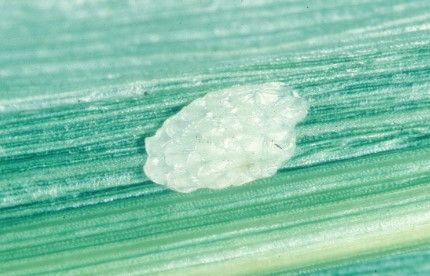
European corn borer completes one to two generations per year in Michigan. The number of generations is dependent on environmental conditions as well as genetic component that varies within populations. Generally, populations in colder areas complete a single life cycle while populations in warmer regions complete two (or more south of Michigan). The geographic distribution of single and multi-generation populations, and their area of overlap, is not well defined in Michigan.
European corn borer overwinters as larvae inside the host plant where it pupates in response to warming temperatures in spring. The first generation flight of moths is expected at 450 growing degree days (GDD) base 50, based on a March 1 start date for GDD accumulation. First generation moth emergence continues for 500 GDD (through 950 GDD base 50) with females laying 200-500 eggs over a period of two to three weeks. Egg development is driven primarily by temperature, but generally eggs hatch in approximately 12 days. Newly hatched larvae then feed externally on leaves for approximately seven days before boring into stems and petioles where they continue to feed and grow.
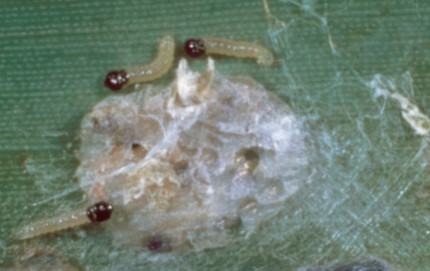
According to the Michigan State University Enviroweather European corn borer model, the average first generation adult flight and egglaying period in Michigan occurs in June (early June in southern Michigan and mid- to late June in northern Michigan). In single generation locations, the larvae generated from this first flight of adult moths will overwinter. In warmer or multigenerational locations, larvae from the first generation pupate and a second adult moth flight and egglaying cycle occurs between 1,450 and 1,950 GDD base 50 (mid-July to mid-August on average). In areas where both one and two generation corn borer co-exist, emergence and development may overlap or occur in succession, making scouting and management difficult. Refer to the Enviroweather European corn borer model for the current European corn borer status. Be sure to select the weather station closest to your hopyard for more accurate information.
Monitoring for European corn borer
Focus on scouting for adults and eggs to allow for corrective management before larvae enter the bine. European corn borer eggs are smaller than the head of a pin but are laid in visible groupings. Eggs are white when first laid but change to yellow and then develop a black spot (the larval head capsule) just before hatching. Eggs are likely deposited on the underside of hop leaves in masses of 20 to 30 and covered with a waxy film.
If available, you may have better luck spotting eggs in adjacent corn fields. European corn borer larvae are light gray to faint pink caterpillars with a dark head and have dark spots along the sides of each segment and a pale stripe along the back. They grow to about 1 inch but start out very small at hatch and feed briefly on leaf tissue before boring into hop bines, and even hop leaf petioles.
European corn borer pupae are smooth, reddish brown, cylindrical and about a half-inch long and found inside bines.
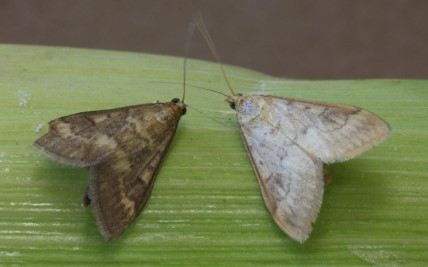
The European corn borer moth is about 1 inch long and light brown with wavy bands across the wings. The male is slightly smaller and darker. The tip of the body protrudes beyond the wings. Adult moths are most active in grassy areas before dawn.
Small European corn borer larvae are the intended target of insecticides, so monitoring for adult moth flight is critical to predicting the start of egglaying and subsequent window of egg hatch. Begin monitoring and trapping well before predicted flight (450 GDD50) to avoid missing the beginning of flight. Simple wing or bucket traps used for other field crop moths cannot be used to trap European corn borer; instead, wire Hartstack or cloth Heliothis traps are used. These traps are cumbersome and expensive and must be positioned carefully in action sites, or grassy locations where European corn borer gather to rest and mate. Use sweep nets in fallow, grassy areas at dusk and dawn.
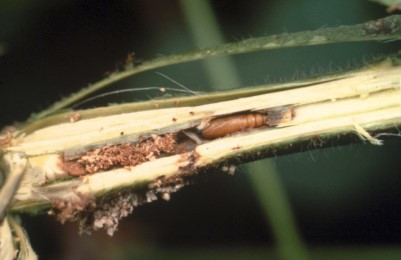
Farms may also consider establishing a cooperative trapping and monitoring system with neighboring hop or corn growers to increase the amount of monitoring information for all. In lieu of trap data, careful crop scouting based on the Enviroweather prediction model can be used as a loose guide.
Symptoms of damage from European corn borer on hop appear as generalized stunting and in some cases wilt. Plants fail to thrive and may lose their ability to climb the coir. Check for stem wounds along bines, particularly where sidearms originate or bines contact each other or the coir. The larval frass (feces) appears a little like sawdust, about the size of large sand grains and is trapped in webbing. You may also see holes or wounding. If you cut open the bines where borer is suspected, you will see discolored tissue, frass and likely the larvae or pupae itself.
Managing European corn borer
There are a number of effective insecticides for managing European corn borer and they should be applied to control larvae before they enter the protection of the bine. Based on research in peppers and the available pesticides to hop producers, spinosad-based insecticides (Entrust, Entrust SC and SpinTor 2SC), chlorantraniliprole (Coragen) and Bacillus thuringiensis (Bt) products provide chemical control of European corn borer larvae in hop. Products containing cyfluthrin (e.g., Tombstone, Tombstone Helios) will also likely be effective though more disruptive to natural enemies, increasing the risk of twospotted spider mite pressure. All of these products should be targeted to control small larvae as they emerge from eggs, once inside the bine insecticides will be ineffective.
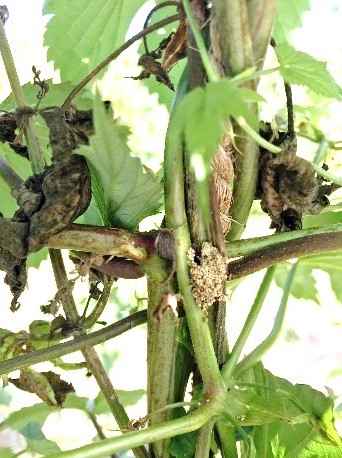
Biological control of European corn borer eggs with the parastitic wasp, Trichogramma ostriniae, has shown efficacy in pepper production research by the University of Massachusetts at Amherst. The wasps were released in peppers weekly during four weeks of European corn borer adult flight, with release rate of 90,000 -120,000 per acre weekly. Using parasitic wasps require modified insecticide use on the farm to protect released insects.
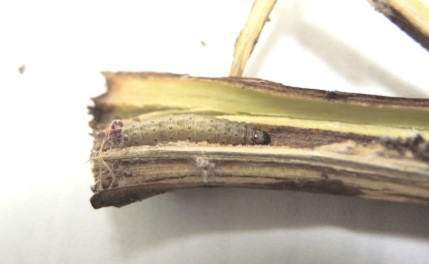
Growers with substantial infestations should carefully dispose of crop waste including chopped bines at the picking line. Consider burying or hot composting crop debris both from the processing line and the field to limit carryover into the next season.
Managing for European corn borer takes a multipronged approach including careful monitoring and targeted pesticide applications. A regular schedule of insecticide applications based on insecticidal residual activity should be maintained from the beginning of egg hatch until two weeks before harvest or when larvae are no longer detected. For more information on European corn borer, refer to the Iowa State University publication, “European Corn Borer – Ecology and Management and Association with other Corn Pests.”
Information presented here does not supersede the label directions. To protect yourself, others and the environment, always read the label before applying any pesticide. Although efforts have been made to check the accuracy of information presented, it is the responsibility of the person using this information to verify that it is correct by reading the corresponding pesticide label in its entirety before using the product. Labels can and do change. For current label and MSDS information, visit one of the following free online databases: greenbook.net, cdms.com and agrian.com. The efficacies of products listed have not been evaluated on hop in Michigan. Reference to commercial products or trade names does not imply endorsement by Michigan State University Extension or bias against those not mentioned.
Source : msu.edu